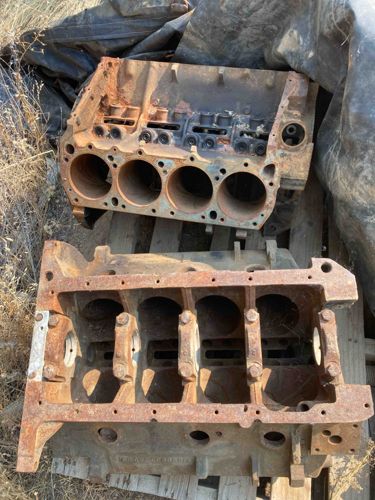
Automotive Engine Blocks (Two Units)
The image displays two automotive engine blocks, likely made of cast iron, exhibiting significant signs of age and exposure to the elements. Both blocks appear to be for internal combustion engines, given their characteristic cylinder bores and main bearing journals. The top block, viewed from above, reveals four prominent cylinder bores, suggesting a 4-cylinder or a portion of an 8-cylinder (V8) engine, if it's one bank. The cylinder walls show signs of surface rust and potential pitting. The deck surface, where the cylinder head would typically mount, is heavily rusted with visible bolt holes for head studs. There are also camshaft bearing saddles or lifter bores visible towards the top-center of the block. The overall color is a deep reddish-brown due to severe oxidation, interspersed with patches of original dark gray or black paint/primer on less exposed surfaces. The casting details are somewhat obscured by the rust. The lower block is turned over, exposing the main bearing webs and main bearing caps, which are still attached to the block. There are five main bearing journals visible, suggesting it's either an inline four-cylinder or a V8 block. The main bearing caps are secured by prominent bolts, also heavily corroded. Similar to the upper block, this component also displays extensive surface rust across all exposed cast iron surfaces. The general construction indicates a heavy-duty, robust design typical of automotive engine components. No discernible manufacturer's marks, signatures, or stamps are clearly visible due to the extensive corrosion and image resolution. Based on the visible characteristics, these engine blocks appear to be from an older vehicle, potentially from the mid-20th century, given the design and the level of degradation, pre-dating widespread aluminum block usage. The condition issues are severe, primarily heavy surface rust, indicating years of outdoor storage or neglect. This level of rust may compromise the integrity of precision surfaces, requiring extensive machining or potentially making them unsuitable for rebuild without significant and costly restoration.
AI-Generated Appraisal Disclaimer
Estimated Value
$50 - $150
Basic Information
Category
Automotive Parts
Appraised On
November 28, 2025
Estimated Value
$50 - $150
Item Description
The image displays two automotive engine blocks, likely made of cast iron, exhibiting significant signs of age and exposure to the elements. Both blocks appear to be for internal combustion engines, given their characteristic cylinder bores and main bearing journals. The top block, viewed from above, reveals four prominent cylinder bores, suggesting a 4-cylinder or a portion of an 8-cylinder (V8) engine, if it's one bank. The cylinder walls show signs of surface rust and potential pitting. The deck surface, where the cylinder head would typically mount, is heavily rusted with visible bolt holes for head studs. There are also camshaft bearing saddles or lifter bores visible towards the top-center of the block. The overall color is a deep reddish-brown due to severe oxidation, interspersed with patches of original dark gray or black paint/primer on less exposed surfaces. The casting details are somewhat obscured by the rust. The lower block is turned over, exposing the main bearing webs and main bearing caps, which are still attached to the block. There are five main bearing journals visible, suggesting it's either an inline four-cylinder or a V8 block. The main bearing caps are secured by prominent bolts, also heavily corroded. Similar to the upper block, this component also displays extensive surface rust across all exposed cast iron surfaces. The general construction indicates a heavy-duty, robust design typical of automotive engine components. No discernible manufacturer's marks, signatures, or stamps are clearly visible due to the extensive corrosion and image resolution. Based on the visible characteristics, these engine blocks appear to be from an older vehicle, potentially from the mid-20th century, given the design and the level of degradation, pre-dating widespread aluminum block usage. The condition issues are severe, primarily heavy surface rust, indicating years of outdoor storage or neglect. This level of rust may compromise the integrity of precision surfaces, requiring extensive machining or potentially making them unsuitable for rebuild without significant and costly restoration.
Get Your Items Appraised
Instant estimates of your treasures with AI-powered instant appraisals